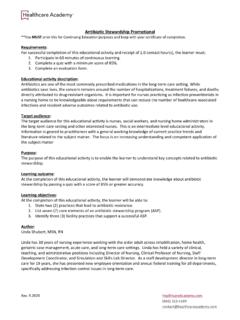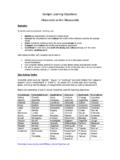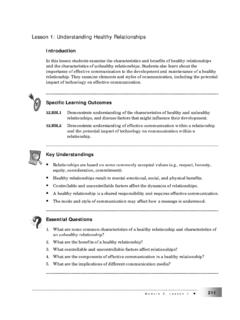Transcription of Evaluation Models, Approaches, and Designs
1 5 Evaluation Models, Approaches, and DesignsBACKGROUNDThis section includes activities that address Understanding and selecting Evaluation models and approaches Understanding and selecting Evaluation designsThe following information is provided as a brief introduction to thetopics covered in these MODELS AND APPROACHESThe following models and approaches are frequently mentioned in theevaluation objectives approach focuses on the degree to whichthe objectives of a program, product, or process have been achieved. Themajor question guiding this kind of Evaluation is, Is the program, product, orprocess achieving its objectives ?
2 The Four-Level Model. This approach is most often used to evaluate trainingand development programs (Kirkpatrick, 1994). It focuses on four levels oftraining outcomes: reactions, learning, behavior, and results. The majorquestion guiding this kind of Evaluation is, What impact did the 7/22/2004 5:44 PM Page 101102 BUILDING Evaluation CAPACITY have on participants in terms of their reactions, learning, behavior, andorganizational results? Responsive approach calls for evaluators to be responsive tothe information needs of various audiences or stakeholders.
3 The major ques-tion guiding this kind of Evaluation is, What does the program look like todifferent people? Goal-Free Evaluation . This approach focuses on the actual outcomes ratherthan the intended outcomes of a program. Thus, the evaluator has minimalcontact with the program managers and staff and is unaware of the program sstated goals and objectives . The major question addressed in this kind of eval-uation is, What are all the effects of the program, including any side effects? Adversary/Judicial Approaches. These approaches adapt the legal paradigm toprogram Evaluation .
4 Thus, two teams of evaluators representing two viewsof the program s effects argue their cases based on the evidence (data)collected. Then, a judge or a panel of judges decides which side has made abetter case and makes a ruling. The question this type of Evaluation addressesis, What are the arguments for and against the program? Consumer-Oriented Approaches. The emphasis of this approach is to helpconsumers choose among competing programs or products. ConsumerReportsprovides an example of this type of Evaluation . The major questionaddressed by this Evaluation is, Would an educated consumer choose thisprogram or product?
5 Expertise/Accreditation accreditation model relies on expertopinion to determine the quality of programs. The purpose is to provideprofessional judgments of quality. The question addressed in this kind ofevaluation is, How would professionals rate this program? Utilization-Focused to Patton (1997), utilization-focused program Evaluation is Evaluation done for and with specific,intended primary users for specific, intended uses (p. 23). As such, itassumes that stakeholders will have a high degree of involvement in many, ifnot all, phases of the Evaluation .
6 The major question being addressed is, What are the information needs of stakeholders, and how will they use thefindings? Participatory/Collaborative Evaluation . The emphasis of participatory/collaborative forms of Evaluation is engaging stakeholders in the evaluationprocess, so they may better understand Evaluation and the program beingevaluated and ultimately use the Evaluation findings for 7/22/2004 5:44 PM Page 102 Evaluation MODELS, APPROACHES, AND Designs 103purposes. As with utilization-focused Evaluation , the major focusingquestion is, What are the information needs of those closest to the program?
7 Empowerment approach, as defined by Fetterman (2001), isthe use of Evaluation concepts, techniques, and findings to foster improve-ment and self-determination (p. 3). The major question characterizing thisapproach is, What are the information needs to foster improvement andself-determination? Organizational Learning. Some evaluators envision Evaluation as a catalyst forlearning in the workplace (Preskill & Torres, 1999). Thus, Evaluation can beviewed as a social activity in which Evaluation issues are constructed by andacted on by organization members.
8 This approach views Evaluation as ongo-ing and integrated into all work practices. The major question in this case is, What are the information and learning needs of individuals, teams, and theorganization in general? Theory-Driven approach to Evaluation focuses on theoreticalrather than methodological issues. The basic idea is to use the program srationale or theory as the basis of an Evaluation to understand the program sdevelopment and impact (Smith, 1994, p. 83). By developing a plausiblemodel of how the program is supposed to work, the evaluator can considersocial science theories related to the program as well as program resources,activities, processes, and outcomes and assumptions (Bickman, 1987).
9 The major focusing questions here are, How is the program supposed towork? What are the assumptions underlying the program s development andimplementation? Success Case Method. This approach to Evaluation focuses on the practicali-ties of defining successful outcomes and success cases (Brinkerhoff, 2003)and uses some of the processes from theory-driven Evaluation to determinethe linkages, which may take the form of a logic model, an impact model, ora results map. Evaluators using this approach gather stories within the orga-nization to determine what is happening and what is being achieved.
10 Themajor question this approach asks is, What is really happening? Evaluation DESIGNSE valuation Designs that collect quantitative data fall into one of threecategories:1. Preexperimental2. Quasi-experimental3. True experimental 7/22/2004 5:44 PM Page 103104 BUILDING Evaluation CAPACITYThe following are brief descriptions of the most commonly used Evaluation (and research) using this design, the evaluator gathers data followingan intervention or program. For example, a survey of participants might beadministered after they complete a with the one-shot design, the evaluator collects data atone time but asks for recall of behavior or conditions prior to, as well as after, theintervention or Pretest-Posttest evaluator gathers data prior to andfollowing the intervention or program being Series Design.



















